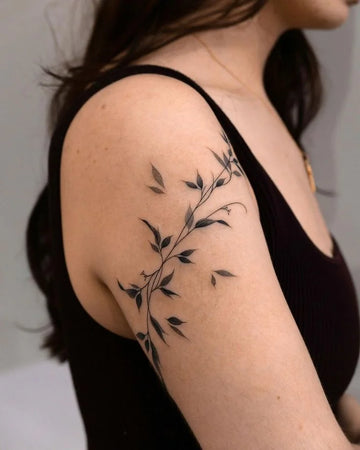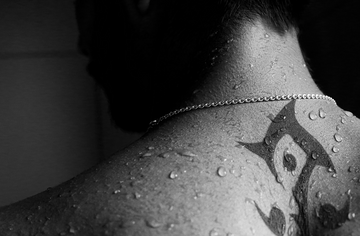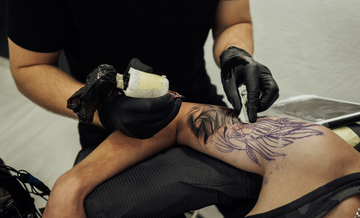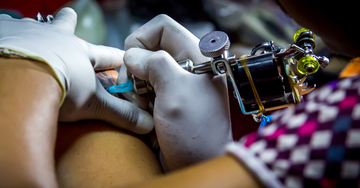What Are Tattoo Wraps?

Definition and Types of Tattoo Wraps
Tattoo wraps are protective coverings applied immediately after getting a tattoo. They act as a barrier between the tattooed skin and external irritants such as bacteria, dirt, and clothing.
Modern Versus Traditional Approaches
Traditionally, cling film or plastic wrap was used, but advancements in tattoo aftercare have introduced breathable, medical-grade wraps like Saniderm and Tegaderm. These newer options are often self-adhesive and waterproof, offering a more comfortable and hygienic solution.
The Science Behind Tattoo Wraps
Tattoo wraps operate on fundamental principles of wound care. Tattoos are essentially open wounds created by needles injecting ink into the dermis layer of the skin. Keeping a fresh tattoo clean and protected reduces the likelihood of complications like infections and scarring.
How Tattoo Wraps Aid in Healing
- Moisture Retention: Keeps the tattoo hydrated, preventing the formation of thick scabs.
- Barrier Protection: Blocks contaminants such as bacteria, dust, and fabric friction.
- Temperature Control: Maintains an optimal environment for skin regeneration.
Benefits of Using Tattoo Wraps
1. Protecting the Tattoo
A fresh tattoo is extremely vulnerable during the first 24-48 hours. Wrapping shields it from bacteria, debris, and accidental contact.
2. Reducing Infection Risks
Studies on wound care emphasize the importance of covering fresh wounds to minimize infection risks. This principle applies to tattoos as well.
3. Promoting Faster Healing
Properly wrapped tattoos heal more consistently, reducing the chances of patchy ink or prolonged redness.
Types of Tattoo Wraps
1. Plastic Cling Wrap
Commonly used in traditional settings, this affordable option provides basic protection but lacks breathability, which can hinder healing.
2. Saniderm and Second-Skin Wraps
These modern wraps are self-adhesive and waterproof, allowing for better air exchange while protecting the tattoo.
3. Reusable and Eco-Friendly Options
Environmentally conscious alternatives include reusable wraps made of silicone or biodegradable materials.
How to Use Tattoo Wraps Effectively
Step-by-Step Guide to Applying and Removing Wraps
-
Initial Application:
- Your artist will apply the wrap immediately after the session. Leave it on for 12-24 hours.
-
Cleaning:
- When removing the first wrap, wash your tattoo gently with lukewarm water and a mild, fragrance-free soap.
-
Re-Wrapping:
- If advised, reapply a fresh wrap. Ensure your hands are clean during the process.
-
Final Removal:
- After 2-3 days, transition to regular moisturizing without wrapping unless directed otherwise.
Best Practices and Common Mistakes
- Avoid leaving a wrap on too long—it can cause excess moisture buildup.
- Don’t use wraps beyond their intended purpose; they are temporary tools.
When to Use Tattoo Wraps
Tattoo wraps are most beneficial during the initial healing phase. Use them:
- Immediately after getting a tattoo to protect it during travel home.
- During physical activities where exposure to sweat, dirt, or friction is unavoidable.
Potential Downsides of Tattoo Wraps
While wraps offer significant benefits, they aren’t without drawbacks:
1. Skin Irritation
Some people may experience allergic reactions to adhesive wraps. Opt for hypoallergenic options if you have sensitive skin.
2. Overhydration
Excess moisture trapped under a wrap can lead to maceration, causing the skin to appear pale and wrinkled. This can delay healing.
Myths and Misconceptions About Tattoo Wraps
“You Must Always Wrap Your Tattoo”
While wrapping is essential initially, it is not always necessary once the tattoo starts healing.
“Wrapping Speeds Up Healing Significantly”
Wraps help by preventing complications, but they don’t directly accelerate the natural healing timeline.
“All Wraps Are the Same”
Not all wraps are created equal. Choose products specifically designed for tattoo aftercare.
Tattoo wraps are an invaluable tool in the early stages of tattoo healing. They provide protection, reduce infection risks, and create an optimal healing environment. However, their effectiveness depends on proper usage and understanding their limitations. By using high-quality wraps and following a professional’s advice, you can ensure your tattoo heals beautifully and becomes a lasting piece of art.
11. FAQs
1. Can I Skip Using a Tattoo Wrap Altogether?
It’s possible, but skipping wraps increases the risk of contamination, especially during the first 24 hours.
2. How Long Should I Keep a Tattoo Wrap On?
Generally, leave the wrap on for 12-24 hours initially, or as instructed by your tattoo artist.
3. Are Tattoo Wraps Reusable?
Most wraps, such as Saniderm, are single-use. However, eco-friendly reusable options are available.
4. Do Tattoo Wraps Work for All Skin Types?
Yes, but people with sensitive skin should choose hypoallergenic wraps to avoid irritation.
5. What Happens If I Use a Wrap Incorrectly?
Improper use, such as leaving it on too long, can lead to overhydration or infection. Always follow professional guidelines.





